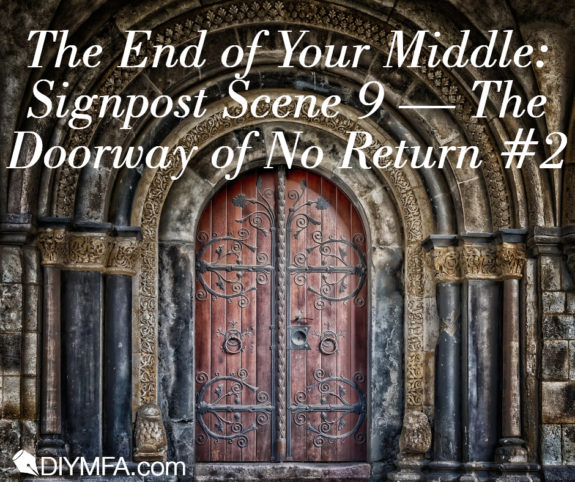Storytelling language can go by many names, especially when it comes to major plot points: point of no return, external and internal conflicts, stakes, etc.
One of the most well-known terms defines a moment essential for every story. It comes at the very end of your middle act and pushes your Lead into a new world where they can never go back. A sister to the Point of No Return, or James Scott Bell’s Doorway of No Return #1, Bell calls this important moment The Doorway of No Return #2. It’s signpost scene #9 in his 14 Signpost Scenes outlined in his brilliant book on structure, Super Structure.
You might know it as the All is Lost moment.
It’s importance? This action defines one of two of your Lead’s major decisions made in the story. It is when she is faced with the choice to go on, quit, or take a new direction.
And like any great heroine, it’s this moment where chaos tries to ruthlessly bolt her to the ground that she must dig deep and discover who she wants to be—how she will transform in order to take on the story’s climax.
With suffering comes opportunity for tremendous triumph. But without the Doorway of No Return #2—without the All is Lost Moment—readers won’t care about the exciting showdown that follows.
Here’s how you write it.
Tying Up Your Middle Act
The Middle Act, or Act II, is the meat of the hero’s journey. Consisting of a healthy 50% of your book’s bulk, this is where your heroine is challenged with tests and trials, where they make enemies and allies, where they face massive external and internal stakes—all of which are leading to the final outcome where your Lead wins, or loses, their primary “want.”
Joseph Campbell called this the “unordinary world,” in other words, your hero’s uncharted territory where they set out to achieve some external goal while challenged with obstacles that stretch their internal limits.
This is the part of the book where Luke Skywalker joins Obi One on the quest to become a Jedi Knight. When Scarlet O’Hara “has to get out of Atlanta with Melanie and her baby before the Yankees arrive.” When Harry Potter enrolls at Hogwarts to become a wizard. When Starr Carter navigates her two worlds with understanding and awareness.
But at the end of your Middle Act, something unavoidably important needs to happen. James Scott Bell says that, “in a novel, the second doorway is a major crisis or setback, or some sort of clue or discovery.”
Whatever it is—action or revelation—this moment needs to be the biggest moment—the traumatic loss—in the second act. Without it, there is no final motivation to hurl your Lead into the Final Act of the book.
And let’s face it, that final showdown is what every reader has been waiting for, so don’t cut readers short.
Little Fires Everywhere — A Major Success
It’s no wonder Celeste Ng’s second novel Little Fires Everywhere (Penguin Random House) was a wild success. Filled with domestic suspense, complex and memorable women, and timely topics that initiate conversations including race, the ugly innards of pretty-pretty suburbs, and abortion, this book’s intense market strategies were only bite-size-bits of what ignited praise.
For a full look at Little Fires Everywhere’s plot, check out this New York Times review.
The book opens in the moment waiting for us at the climax: Izzy, the youngest Richardson daughter, is suspected of burning her house down. All her siblings—and her parents—think she did it. Plus, she’s missing. There’s nobody willingly left to defend her. Nobody in town who thinks otherwise.
With this mystery in place—paired with the riveting domestic tension binding the Richardsons—readers forge forward wondering if Izzy is indeed the culprit of the fires, and if she is, why she did it.
But what readers get is something far more than a fire-burning mystery: we experience a deep look at a quiet suburb in Ohio and the tantalizing family secrets exposed inside the town’s (too-finely) manicured walls.
And while the cast is an ensemble that includes individual members from the Richardson family, it is Mia and Pearl Warren—the newcomers to the town—who are the Leads driving the story’s macro conflict. Mia in particular. Mia, the single-mother of Pearl, the artist, the unconventionalist, the one who understands what it’s like to live the life less-traveled, and the sacrifices that this choice often comes with.
Mia is the Lead and the heroine that the reader uses to witness and understand the corrupt events intoxicating the town of Shaker Heights. But at what cost? Mia’s “threatening” way of life—her meddling in a court case that infuriates nosey Mrs. Richardson—is what gives Mrs. Richardson the delusional belief that she is justified in exposing Mia’s skeletons. (Gag.)
And it’s this confrontation, this searing tension, that delivers the All is Lost moment in the end of Act II.
Mia’s Doorway of No Return #2
By the three-quarter mark (page 227) a lot has happened. Mia, single mother and artist, lives an unconventional lifestyle foreign to the fancy, privileged town of Shaker Heights. And for someone like Mrs. Elena Richardson, different (whether she’s admit this to herself or not) is a threat.
At its macro level, Mia finds herself center-stage in this tight-knit community: she avoids her past, she learns of the whereabouts of her Chinese friend Bebe’s baby, and she shares this information with Bebe—encouraging her to file to get her nearly-adopted daughter back. And during all of this, Mia freely lives on the outside; she observes the sticky interior tangled inside the conventions governing this tiny town at a small distance.
By the time Doorway of No Return #2 (end of Act II) rolls around, the truth of Mia’s mysterious past is revealed: (spoiler alert!) she ran away from her family while pregnant with her daughter Pearl, who she was under contract to give to another married couple (she was a surrogate mother).
Through backstory, we’ve learned that Mia has a poor relationship with her parents—the last line severed at an especially low time in her life: her brother Warren was killed in a car accident, and her parents disown her at the mere thought of her selling her baby to another couple.
Mia is familiar with disagreements between her and her mother, but usually her father steps in with some inkling of support. This is not the case at Doorway of No Return #2; the knife already piercing her heartbreaking wounds twists: her father rejects her decision—and her, too.
Mia glanced at her father. She felt exactly as she had as a child, when she’d broken something or ruined something or spent on the film the money that her mother had meant for clothes: in those moments her mother would rage and scream and run to her room, leaving Mia with her father, who would squeeze her hand and let the quiet lap over them like milk, then say quietly, “Buy a new one,” or “Give her an hour, and go apologize,” or sometimes, simply, “Fix it.” This was how they’d always fought. But this time her father did not take her hand. He did not say to her, Fix it. Instead he looked at her belly, as if he couldn’t bear to look at her face. His eyes were wet and his jaw clenched.
“Dad?” she said at last. She would have preferred shouting to this protracted, knife-sharp silence.
“I can’t believe you’d sell your own child,” he said, and then he, too, left the room.
This. This is Mia’s lowest moment. While told in backstory, this scene is what sheds light on the events that have brought Mia to where she is in the story’s present, living in Shaker Heights with Pearl. Mia is happy with her life and decisions. Joyous, in fact, but the largest skeleton in her closet hangs on the reality that she’s never told Pearl the truth about her father.
Plus, Elena Richardson has done some seriously intrusive digging to find out the truth.
Knowing this All is Lost moment is what sets the reader up for the quickly approaching climax in Act III: Elena, the antagonist for Mia and another essential character in the book, is going to use this information to threaten Mia. As readers, we sit in anxious anticipation of how Elena is going to treat Mia, how Mia will respond, and what the outcome for this amazing heroine will be in the end.
But we wouldn’t care half as much if we didn’t know who Mia was and what she is up against.
Why Every End of Middle Act Needs a Doorway of No Return #2
As James Scott Bell points out in his novel Superstructure, “Unless there is a way to get to the final battle, Act II will go on forever. The natural rhythm, of the three-act structure dictates that this second doorway open up with about one quarter or a little less of the book left.”
If you don’t believe me, go examine some of your favorite masterworks and ask yourself this: when Act II comes to a close, do you see some earth-shattering, broken, all is lost moment? Does the world seem to crash down on your Lead, and if it does, does it force them to make a major decision?
It’s this decision, to walk through the Doorway of No Return #2, that raises the macro story’s external and internal stakes. That prepares us, eyes glued to the page, for the final showdown quickly approaching.
In life, it sometimes takes losing what’s essential to realize how much we cherish something else. In stories, this is brought into the light by an All is Lost moment awakened in the Doorway of No Return #2.
Put Doorway of No Return #2 into Practice
What’s waiting for your Lead at the end of the middle act? What kind of cataclysmic event resuscitates the reality of that Lead’s “All is Lost”—i.e. worst thing that could happen to them—in that moment? Knowing this is essential to elevating your macro story’s internal and external stakes.
Write 500-words on this idea. Talk it out in the comments! Draw a picture or make a vision board that mirrors your Lead’s emotions in this moment.
When you’re done, write the scene. Let it rest. Go back and rewrite. Rewrite again.
On the read it rips your Lead raw—stop.
Congratulations, you’ve written something unquestionably beautiful! And essential for a strong story’s structure.

Abigail K. Perry is an editorial intern for P. S. Literary Agency as well as a women’s and fantasy/women’s fiction writer (she’s an aspiring literary agent, freelance editor, and published author). Abigail is getting certified in The Story Grid editing methodology in Feb 2019.
During her day job, Abigail teaches creative writing and film production to grades 9-12. She received her B.S. in TV, Radio, and Film from Syracuse University and her Master’s in Education from Endicott College; she has interned as a creative production intern for Overbrook Entertainment and as a marketing and sales (special projects) intern for Charlesbridge Publishing.
In other experiences, Abigail is a member of the DIY MFA street team and a loyal follower of Writer’s Digest and The Story Grid, where she has participated in a number of conferences, retreats, workshops, and webinars. She holds stories close to her heart, and she’s always looking for ways to help writers polish/sell their #WIP into a publishable manuscript. For more #WritingCommunity #WriteTip #AmWriting #WritingPrompt #AmEditing #AskEditor resources, follow Abigail on twitter @abigailkperry, Instagram @abigailkperry, and website www.akperry.com.







